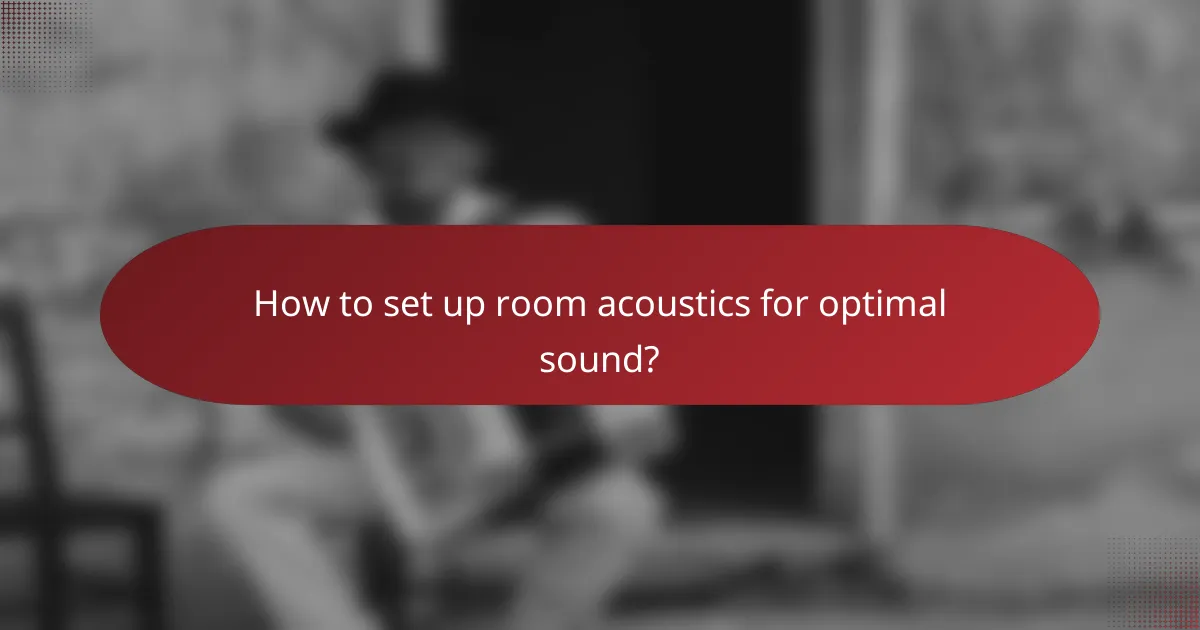Room acoustics play a crucial role in achieving high-quality sound in various environments, from home studios to listening rooms. By strategically incorporating acoustic panels, bass traps, and diffusers, you can effectively control noise and enhance sound clarity. Key considerations such as room shape, size, and material can significantly impact your audio experience, making thoughtful setup essential for optimal performance.

What are the best room acoustics solutions for home studios?
The best room acoustics solutions for home studios include a combination of acoustic panels, bass traps, diffusers, and soundproofing techniques. These elements work together to enhance sound quality, control unwanted noise, and create an optimal recording environment.
Acoustic panels for sound absorption
Acoustic panels are designed to absorb sound waves, reducing echo and reverberation in a room. They are typically made from porous materials that trap sound energy, making them effective for improving clarity in recordings and performances.
When selecting acoustic panels, consider their thickness and density, as thicker panels generally absorb lower frequencies better. Positioning them strategically on walls and ceilings, particularly at first reflection points, can significantly enhance sound quality.
Bass traps for low-frequency control
Bass traps are specialized acoustic treatments that target low-frequency sounds, which can often cause muddiness in recordings. These traps are usually placed in corners where low frequencies tend to accumulate, helping to balance the overall sound in the studio.
For effective bass control, choose traps that are at least 4 inches thick and made from dense materials. A common practice is to use a combination of corner bass traps and wall-mounted units to achieve a well-rounded acoustic environment.
Diffusers for sound scattering
Diffusers scatter sound waves rather than absorbing them, which helps to maintain a lively sound in the studio while minimizing harsh reflections. They are particularly useful in larger spaces where a flat, reflective surface can create unwanted echoes.
When implementing diffusers, consider their shape and material. Quadratic diffusers are popular for their effectiveness across a range of frequencies. Placing them on rear walls or ceilings can enhance spatial quality without deadening the sound.
Soundproofing techniques for isolation
Soundproofing techniques aim to prevent external noise from entering the studio and internal sound from leaking out. This is crucial for maintaining a clean recording environment and ensuring privacy during sessions.
Common soundproofing methods include adding mass to walls with heavy materials, sealing gaps with acoustic caulk, and using double-glazed windows. For optimal results, combine these techniques with acoustic treatments to create a comprehensive sound isolation strategy.

How to set up room acoustics for optimal sound?
To achieve optimal sound in a room, focus on reducing unwanted noise and enhancing sound clarity through strategic placement of acoustic treatments and furniture. Proper setup can significantly improve audio quality, whether for music production, home theaters, or general listening environments.
Placement of acoustic panels
Acoustic panels should be strategically placed at first reflection points, which are the locations where sound waves bounce off walls and reach the listener’s ears. Common areas for panel placement include the walls adjacent to speakers and the ceiling above the listening area.
For best results, consider using a mix of absorption panels and diffusion panels. Absorption panels reduce echo and reverberation, while diffusion panels scatter sound waves, creating a more balanced auditory experience. A good rule of thumb is to cover about 20-30% of the wall surface area with acoustic panels.
Arranging furniture for sound reflection
Furniture arrangement plays a crucial role in sound reflection and absorption. Soft furnishings like sofas and curtains can absorb sound, while hard surfaces like glass and wood can reflect it. Positioning furniture away from walls can help minimize reflections that may distort sound.
To optimize sound quality, create a triangular layout between the speakers and the listening position. This arrangement allows for better sound staging and clarity. Avoid placing large furniture directly in front of speakers, as this can obstruct sound waves and lead to muddiness.
Measuring room dimensions for treatment
Accurate measurement of room dimensions is essential for effective acoustic treatment. Start by measuring the length, width, and height of the room to understand its acoustical properties. Consider the ratios of these dimensions, as certain ratios can enhance sound quality while others may lead to problematic resonances.
Once measurements are taken, use them to calculate the optimal placement of acoustic treatments. For instance, rooms with a height-to-width ratio of 1:1.5 are often more acoustically favorable. Additionally, consider using software or apps that can help simulate sound behavior based on your room’s dimensions.

What are the key considerations for room acoustics?
Key considerations for room acoustics include the shape and size of the space, the materials used in its construction, and the positioning of listeners within it. These factors significantly influence sound quality, clarity, and overall listening experience.
Room shape and size impact
The shape and size of a room play a crucial role in how sound waves travel and interact. For instance, rectangular rooms often create standing waves, which can lead to uneven sound distribution. In contrast, irregularly shaped rooms can help diffuse sound, reducing echoes and improving clarity.
When designing or treating a space, aim for a balance between dimensions. A room that is too small may amplify unwanted frequencies, while a very large room can make sounds feel distant. Ideally, consider dimensions that allow for a good mix of low and high frequencies, typically in the range of 2.5 to 4 meters in height.
Surface materials and their effects
Surface materials significantly affect how sound behaves in a room. Hard surfaces like concrete and glass reflect sound, potentially causing echoes, while soft materials such as carpets, curtains, and acoustic panels absorb sound, reducing reverberation. A mix of both types of materials is often best for balanced acoustics.
For practical application, consider using acoustic treatment products like foam panels or bass traps in corners to manage low-frequency buildup. A general rule is to cover about 20-30% of wall surfaces with absorptive materials to achieve a more controlled sound environment.
Listener positioning for best experience
Listener positioning is vital for optimal sound experience. Ideally, listeners should be placed at the “sweet spot,” which is typically one-third of the way into the room from the front wall. This position helps to minimize the effects of reflections and standing waves.
To enhance the listening experience, ensure that seating is arranged symmetrically relative to speakers. Avoid placing listeners too close to walls, as this can lead to an exaggerated bass response. Experiment with different placements to find the most balanced sound, adjusting as necessary based on the room’s unique acoustics.

What tools can help analyze room acoustics?
Several tools can effectively analyze room acoustics, including software and mobile applications designed for measurement and analysis. These tools help identify sound issues and suggest improvements for optimal acoustic performance.
Room EQ Wizard for measurement
Room EQ Wizard (REW) is a powerful software tool used for measuring and analyzing room acoustics. It provides detailed frequency response graphs, impulse response measurements, and other data that help users understand their room’s acoustic characteristics.
To use REW, connect a calibrated microphone to your computer and follow the software’s step-by-step instructions for conducting measurements. This tool is particularly beneficial for identifying problematic frequencies and suggesting treatment options.
Smartphone apps for acoustic analysis
Smartphone apps for acoustic analysis offer a convenient way to assess room acoustics without the need for extensive equipment. Many of these apps utilize the device’s built-in microphone to measure sound levels and frequency response.
Popular apps like Sound Analyzer App and Acoustic Analyzer provide user-friendly interfaces and basic analysis features. While they may not offer the depth of professional software like REW, they are useful for quick assessments and initial evaluations of room acoustics.

What are the costs associated with room acoustics treatment?
The costs for room acoustics treatment can vary significantly based on the chosen approach, whether DIY or professional services. Generally, DIY solutions are more budget-friendly, while professional services offer tailored expertise at a higher price point.
Budget for DIY acoustic solutions
DIY acoustic treatment can range from low-cost materials to more specialized products. Basic solutions like foam panels or curtains can cost anywhere from $50 to a few hundred dollars, depending on the size of the room and the materials used. For effective results, consider using a mix of absorption and diffusion materials.
Common DIY options include using heavy blankets, carpets, or even homemade acoustic panels made from insulation boards. Always measure your space and calculate how much material you will need to avoid overspending.
Pricing for professional acoustic services
Professional acoustic treatment services typically range from several hundred to several thousand dollars, depending on the complexity of the project and the size of the space. A basic consultation might start around $200, while comprehensive design and installation can exceed $2,000.
When hiring professionals, request detailed quotes that outline the scope of work, materials, and expected outcomes. This ensures you understand what you are paying for and helps avoid unexpected costs during the project.

How do room acoustics affect music production?
Room acoustics significantly influence music production by altering sound quality and clarity. Factors such as room size, shape, and materials can enhance or diminish audio fidelity, impacting the overall recording experience.
Influence on recording quality
The acoustics of a room directly affect the recording quality by influencing how sound waves interact with surfaces. Hard surfaces can create reflections, leading to echoes and a muddied sound, while soft materials can absorb sound, resulting in a clearer recording. Understanding these dynamics is crucial for achieving high-quality audio.
To optimize recording quality, consider the dimensions of your space. A room with a balanced ratio of height, width, and length can minimize standing waves and resonances. Aim for a room that is not perfectly square, as this can exacerbate acoustic issues.
Common pitfalls include neglecting bass traps and diffusers. Bass frequencies often accumulate in corners, leading to an unbalanced sound. Installing bass traps can help manage low-end frequencies, while diffusers can scatter sound waves, creating a more even acoustic environment.










